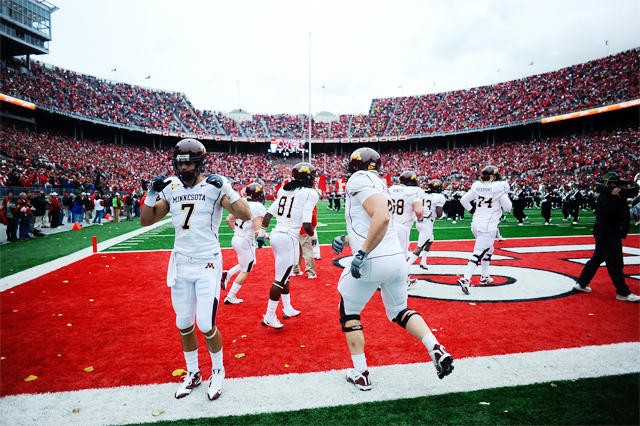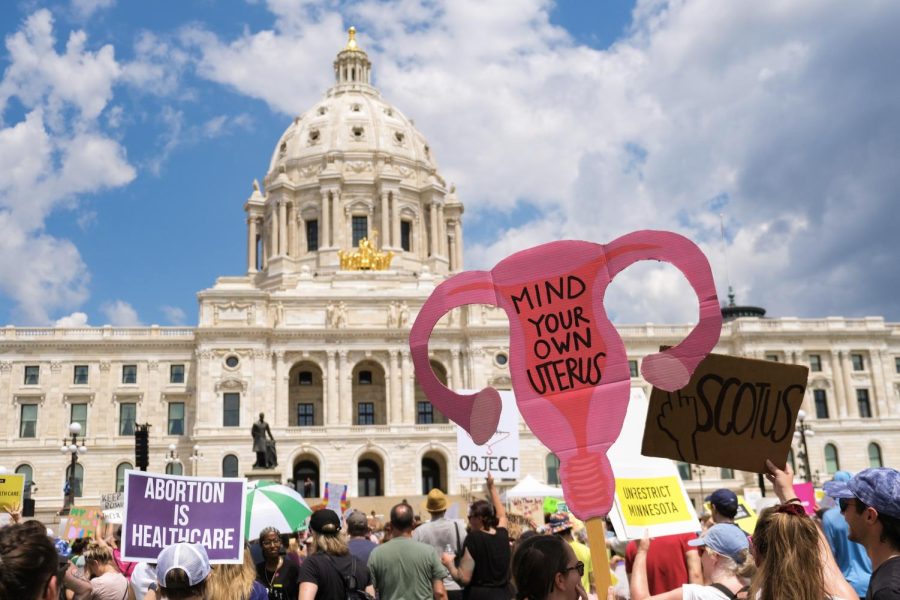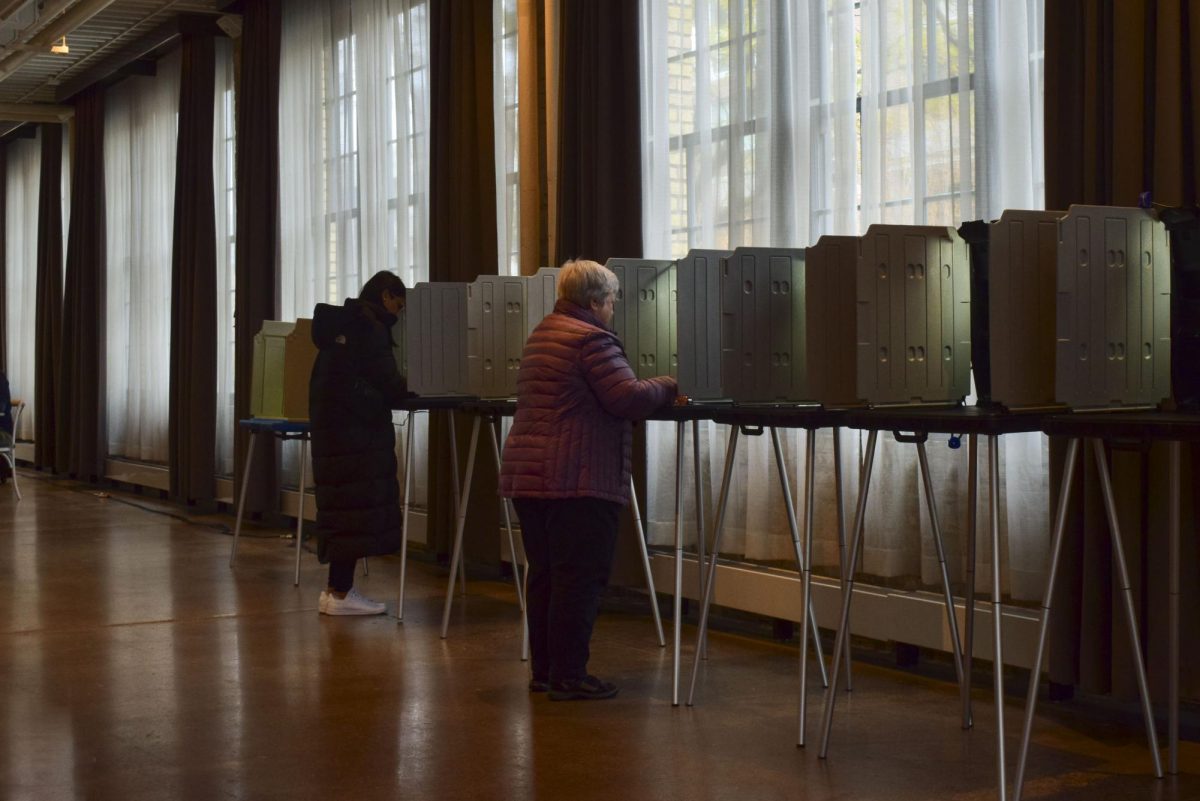In recent years, a growing number of colleges have used corporate sponsorships, sold-out football stadiums and television revenue to monetize their athletics departments. The University of Minnesota is not one of them.
Instead, the athletics department has relied upon a bumped debt payment, timely donations from alumni and help from the Big Ten Conference and the University itself in its attempt to maintain balanced finances. The distribution money Minnesota receives from the Big Ten has helped the athletics program avoid catastrophic losses. But the rich âÄî namely Ohio State, Penn State and Michigan, each among the largest programs in the country âÄî continue to get richer.
In the 2009 fiscal year âÄî which ended last June âÄî the Ohio State, Michigan, Michigan State and Penn State athletics departments each reported more than $14 million in profit to the U.S. Department of Education. Minnesota, with $69.3 million inexpenses and $67.7 million in revenue, needed to draw $1.6 million from the athletics endowment to balance its budget. The athletics department generated $25 million less revenue than Penn State and Michigan and nearly $50 million less than Ohio State.
Though Big Ten money has kept athletics finances afloat, competing against the conferenceâÄôs âÄî and the countryâÄôs âÄî ever-rising tide of money has stretched athletics finances and forced the department to search for new ways to generate revenue and balance its budget.
A “$6.8 million problem”
In the spring of 2009, with the fiscal year drawing to a close, MinnesotaâÄôs athletics department faced a pending shortfall of millions of dollars. But in May and June, as preferred seating became available at the new TCF Bank Stadium, the athletics departmentâÄôs fundraising team procured 255 donations from corporations and individuals totaling at least $2 million. That number could be much larger, as the University foundation reports only a range rather than exact amounts, and donations smaller than $5,000 are not reported.
The department received gifts from banks and financial groups, plumbing and construction companies, a funeral home and at least $10,000 from âÄúCelebrity Fight Night.âÄù These businesses were joined by dozens of individual private donors. Three-fourths of the gifts received by the athletics department are for preferred seating in football, basketball or hockey, Associate Athletics Director David Crum said. Donations which are attached to ticket preferences are considered 80 percent tax deductible. Unattached donations, which Crum said make up the remaining one-fourth of gifts received, are 100 percent tax-deductible.
The donations, for tickets or otherwise, are considered athletics revenue. Crum and his staff draw from a regular pool of donors who make similar commitments from year to year. To secure the largest donations, Crum said, Athletics Director Joel Maturi or even University President Bob Bruininks might meet in person with a prospective donor.
The break-even year in 2009 meant that only once in the previous five fiscal years has MinnesotaâÄôs athletics revenue been comfortably ahead of its annual expenses. In fiscal year 2008, Minnesota reported a $2.3 million positive balance. But the departmentâÄôs financial success that year was not necessarily of its own making: 2008 was the first year of the Big Ten Network and also marked the beginning of a new, larger TV contract for the conference with ESPN and ABC.
According to nonprofit tax forms filed with the IRS, each Big Ten school received $18.8 million in revenue from the conference in 2008, a $4.8 million increase from the previous year. The distribution was vital in balancing the GophersâÄô finances, said Associate Athletics Director Liz Eull, who is in charge of MinnesotaâÄôs athletics finances.
âÄúItâÄôs fair to say that without the Big Ten Network money, we might look very, very different today,âÄù Eull said. âÄúBecause I donâÄôt know where we would have come up with another six-and-a-half million dollars to support the expenditures for the 25 teams that we currently have. I canâÄôt tell you what would have happened. I mean, I donâÄôt have a crystal ball, but I canâÄôt even begin to tell you where we would have gone for, at that time, almost 10 percent of our budget.âÄù
The âÄúsix-and-a-half-million dollarsâÄù Eull referred to is the lingering loss from the previous year, when Minnesota fired, bought out and replaced its football coach and its menâÄôs basketball coach. To help recover the losses, the University loaned athletics $4 million in 2008. In addition, a $3.5 million debt payment by athletics, which had previously been paid each June 30 âÄî the last day of the fiscal year âÄî was instead bumped to July 1, 2008. The one-day bump moved the payment onto the next fiscal yearâÄôs account.
Eull said the payment date was moved permanently and that it was the UniversityâÄôs solution to their shared âÄú$6.8 million problem.âÄù
âÄúI think it was just a timing issue,âÄù University Vice President and Chief Financial Officer Richard Pfutzenreuter said. âÄúIt wasnâÄôt, in my mind, at the time that somebody was trying to hide the ball.âÄù
The University does more than make loans or move payments to improve athleticsâÄô bottom line. It also directly subsidized the department with $3.4 million last year. This money is also counted as revenue. Maturi said that when he arrived at Minnesota eight years ago, the University was giving more than $8 million annually to athletics. Though he and his staff have winnowed the number down, the University athletics department received more money in fiscal year 2008 from its university than any other public Big Ten school, according to a database compiled by ESPNâÄôs Outside the Lines.
In total, athletics received more than $26 million from the University in the past five years.
âÄúIt would be nice to be able to have reserves, and it would be nice to not be dependent on any central allocated dollars,âÄù Maturi said. âÄúI would argue that weâÄôre very close to that.âÄù
Maturi has seen athletics expenses and revenue each increase by more than 50 percent during his tenure. This rise in spending has outpaced the growth of the UniversityâÄôs total expenditures, mirroring a national trend. Maturi said that the largest changes in recent years are seen in coach compensation, pointing to the change at Kentucky since menâÄôs basketball head coach Tubby Smith left that school to join the Gophers.
âÄúTubby was making $2.1 million, now three years later, [John] CalipariâÄôs making $4 million,âÄù Maturi said. Then, throwing up his arms in disbelief, Maturi asked, âÄúWhat?âÄù
âÄòWhat theyâÄôre stuck withâÄô
Last fall, an NCAA-commissioned study found that 25 programs reported positive net revenue in fiscal year 2008, up from 19 schools in 2006. The report also found that âÄúexpenses were increasing at only a slightly faster rate than revenues,âÄù and that âÄúlosses continue to grow.âÄù Among those that lost money in the Football Bowl Subdivision, which includes the largest programs, the average deficit reported was $9.9 million.
The report stated that âÄúallocated revenues,âÄù those funds which came directly from the school or state, had risen from 20 percent of total revenue in 2006 to 30 percent in 2008. How could revenues from commercial activity be rising, while losses âÄî both by athletics programs and universities âÄî arealso increasing?
According to J. Douglas Toma, associate professor at the Institute of Higher Education at the University of Georgia, a small group of elites has elevated itself above the rest.
âÄúThe leading programs have separated themselves even further from the pack,âÄù Toma said. âÄúAnd the places that are not there yet, that are behind that, feel increasing pressure to make potentially bad decisions to either attempt to keep pace, or, in theory, to move ahead. But thatâÄôs pretty unlikely.âÄù
The leading pack includes several of MinnesotaâÄôs conference members. Four Big Ten schools reported profits greater than $15 million last year. Among the 15 highest revenues reported to the U.S. Department of Education in fiscal year 2009, six were Big Ten schools. In TomaâÄôs way of thinking, those who would seek to minimize college athletics are fighting a losing battle. âÄúEven to regulate it further seems unrealistic to me,âÄù Toma said.
âÄúSo I just think studying how institutions employ what they âÄî if you want to put it in these terms âÄî what theyâÄôre stuck with, is a much more useful set of questions.âÄù
âÄòThe big pushâÄô
Larry Faulkner, who was president of the University of Texas from 1998-2006, said he took a hands-off approach to athletics, leaving day-to-day maintenance to a vice president. But Faulkner approved developments which have now made TexasâÄô athletics department the largest of all time, with $138 million in reported revenue last year. Faulkner said that since TexasâÄô football national championship in 2005, ticket prices and TV appearances have risen.
While he was president, he also signed off on an addition to Darrell K Royal-Texas Memorial Stadium. During its national championship season, Texas had $60.8 million in football revenue. Last year, it was $87.6 million.
Though FaulknerâÄôs former school is now the countryâÄôs top spender and earner, he said that even schools making a profit âÄî last year TexasâÄô athletics profits exceeded $25 million âÄî might be pushing things too far.
âÄúThe overall growth is a serious concern,âÄù Faulkner said. âÄúNobody has been smart enough to figure out a way to deal with that issue at this stage.âÄù
In May of last year, the Congressional Budget Office released a report on the tax status of college athletics. The report suggested that the âÄúlarge sumsâÄù now accumulated by some athletics programs, which are technically nonprofit organizations and therefore tax-exempt, âÄúraise the questions of whether those sports programs have become side businesses for schools,âÄù and cited âÄúactivities âĦ only loosely connected to educating students.âÄù
Gene Budig, who served as chancellor at Kansas from 1981-1994, said the links between athletics departments and corporate contracts were just beginning to appear in the early 1990s, toward the end of his tenure.
âÄúIt was the beginning of the big push,âÄù Budig said. âÄúIt was apparent that [commercialization] was the direction of intercollegiate athletics nationally. And what we feared transpired. In many ways, it has been out of control for a number of years.âÄù
John Feinstein, the bestselling author of numerous books on college sports, traces the changes back several decades.
âÄúThere was an explosion of all sports in the last 30 years,âÄù Feinstein said. âÄúIn the process of the money becoming so big, these schools were more and more willing to sell their souls to make that money.âÄù
Maturi has seen the change during his own career, which spans 23 years at the collegiate level.
âÄúWithout a question, itâÄôs far more of a business today than when I got into athletics administration,âÄù Maturi said.
The University of Minnesota athletics department has contracts with Nike and Learfield Sports, which buys the departmentâÄôs marketing rights. Its new football stadium, which Maturi coyly refers to as âÄúthis little building down the street,âÄù is named for a bank. Maturi said that an athletics program could probably exist without these corporate relationships, but he does not know what it would look like.
âÄúI guess itâÄôs possible,âÄù Maturi said. âÄúI donâÄôt know any institution that does that.âÄù
Droughts and new streams
Though cuts were made in football and menâÄôs hockey expenses last year, Minnesota had eight sports with total costs of more than $1 million, while menâÄôs track and womenâÄôs hockey topped $900,000. Of these, all but three sports lose money, some more than others: last year, womenâÄôs basketball operated at a $2 million loss.
With its profitable menâÄôs hockey team, Minnesota is among a handful of schools in the country with three positive revenue sports. But the programâÄôs financial success depends on menâÄôs basketball and, especially, football. In these two sports, the past 10 years have been a decade to forget.
The No. 20 ranking earned by the 2003-04 Gopher football team was the only time either menâÄôs basketball or football finished the season ranked in the Top 25. Not counting the vacated championship of 1996-97, Minnesota has not won a Big Ten menâÄôs basketball championship in more than 25 years. In football, the drought goes back to 1967.
In its two major revenue sports, Minnesota has made two visible financial commitments in recent years with the construction of TCF Bank Stadium and the hiring of national champion basketball coach Tubby Smith. But the athletesâÄô success and the athletics departmentâÄôs bottom line are not always directly linked. Though top earners Texas, Florida and Ohio State are often in the hunt for a national football or basketball championship, the same cannot be said of Michigan, Penn State or Wisconsin, which typically rank in the top 10 nationally in athletics revenue.
Consider the worst year of GophersâÄô football history. During its 1-11 season in 2007, MinnesotaâÄôs football revenue âÄî buoyed by the influx of TV money from the Big Ten âÄî was $21.9 million, nearly $12 million more than its football expense and a $6 million jump in revenue from the previous year.
Last year, Minnesota received $6.2 million from Learfield Communications, which has a multi-year contract for its sports marketing rights. Combined with the Big TenâÄôs allotted distribution, the athletics department is guaranteed to receive tens of millions of dollars whether its teams win all or none of their games.
As Maturi explains it, the departmentâÄôs next challenge is developing more revenue streams. He and Eull cited revenue missing from the departmentâÄôs bottom line, such as money accrued from on-campus parking and the recent decision by the Board of Regents against liquor sales at on-campus sporting events. Pfutzenreuter said that an increase in athletics expenses or revenue would not come from his office, at least not any time soon.
âÄúThatâÄôs up to athletics,âÄù Pfutzenreuter said. âÄúBut if theyâÄôre going to grow their expenses, theyâÄôre going to have to find new revenue sources. Because itâÄôs not coming from the state and itâÄôs not coming from the University, with the budget pressures that we face.âÄù
âÄòPressure from all sidesâÄô
Toma said the pressure to expand and spend comes mostly from alumni. Budig recalls âÄúpressure from all sidesâÄù during his time as KansasâÄô chancellor.
âÄúBigness in athletics was appalling to faculty of my era,âÄù Budig said. âÄúAnd obviously, the people, the state, wanted a winner, something to point to with pride. Alumni and friends of the university indicated that they would freely support such an end. And they did.âÄù
Joel Maturi hears from his alumni, as well. He wants their support, emotionally, and the program needs it, financially.
In 2003, when budget shortfalls left menâÄôs gymnastics and both golf teams on the chopping block, more than 1,700 donors pitched in $2.8 million to save the sports, including $675,000 in a telethon. More than 1,500 alumni donated money toward the construction of TCF Bank Stadium. But Maturi said that alumniâÄôs expectations and demands must be realistic.
âÄúI think you need to know who you are,âÄù Maturi said. âÄúAnd we at Minnesota are always going to be mid-Big Ten level, because thatâÄôs where our revenues are.âÄù
For some fans, this is unacceptable. Maturi said he gets dozens of letters and e-mails each day and has a personal policy of replying to all of them.
Or almost all: It was only about a year ago that Maturi stopped replying to the most profane letters. On Wednesday last week, Maturi considered a postcard he had received from an alumnus informing him that the football teamâÄôs white jerseys made the players look like âÄúwimps,âÄù and asking about the teamâÄôs loss in the Insight Bowl game.
âÄúCanâÄôt we come up with a tough running back in the whole state of Minnesota?âÄù the alumnus asked. Minutes later, Maturi stood up from his desk and left his office. He was off to meet a University regent, where he would face a different, perhaps more useful set of questions. Maturi said that when the desires of fans and regents come into conflict, he must choose whatâÄôs best for the school. âÄúThatâÄôs simple, because I am part of the academic institution,âÄù Maturi said. âÄúWe are. The University of Minnesota athletics department is part of this big University, and I have an obligation to do what we can to have a balanced budget.âÄù








